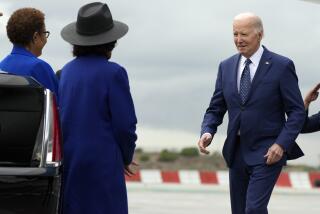Beefing Up Security on Cruise Ships
- Share via
One of the great traditions of the cruise vacation--the pre-sailing bon voyage party aboard--will soon be history. Many cruise lines have already banned them and the others are likely to follow suit.
No more will we be able to invite half a dozen friends into our staterooms to see us off over champagne. No more will we hear the cries of “You lucky thing, you. . . .”
No more the “oohs” and “ahs” of those destined to be on the shore-side end of the colored streamers.
The bon voyage party has become a victim, along with so much else in these tortured mid-1980s, of the fear of terrorism.
Screening hundreds of well-wishers plus those who are about to sail, the lines have decided, is too time-consuming, too cumbersome and too expensive. “No Visitor” signs are up at passenger piers all over the nation.
It is by no means certain that such a rule, had it been in effect at the time, would have prevented the infamous 1985 hijacking of the Achille Lauro, of course. Barring visitors is not meant to be the total answer to terrorism.
Protecting Customers, Ships
It is, rather, just one of the steps that the cruise industry is taking to protect its ships and its customers from thugs.
Electronic metal detectors have become standard operating procedure at many ports. And they will become more common still; you can make book on that.
Specially trained sniffer dogs, which can detect explosives in baggage, have also been used at some terminals, including Los Angeles. They, too, can be expected to play more of a role in protecting shipping and passengers than ever before.
Cruise lines, which didn’t rate security (at least, security from attack) all that problematical two years ago, have suddenly begun to assign it a much higher priority. The Achille Lauro incident taught them that airplanes aren’t the only target of international bandits.
Terrorist profiles, a la the airlines, are being developed and trained personnel are being hired to eyeball crowds around cruise ships seeking those who fit the outline. And those new, and crucial, employees are not being found through newspaper help wanted ads.
Instead, they are being retained through contracts with some of the nation’s most experienced security companies. These firms are having difficulty filling orders, so sought after has their expertise become.
All of this is very costly. Eventually, it will almost certainly be reflected in the prices charged by the cruise operators. For the moment, the industry’s chronic overcapacity is discouraging them from passing on the extra expense to customers.
By and large, the ship lines have acted responsibly, promptly and voluntarily to provide greater protection for their ships and their guests. The “no visitor” policy is a very obvious sign of their concern; much more goes on behind the scenes that passengers may never know about.
Congress has not been sitting on its hands and is not prepared to leave the matter on a voluntary basis. Both the House and the Senate recently approved a new Maritime Security Law that will set standards for foreign and U.S. flag ships and ports.
As a first step, this country will seek a worldwide agreement through members of the International Maritime Organization. That agreement must encompass passenger screening procedures, dock security, on-board measures and so on.
While that agreement is being negotiated, the Department of Transportation has been ordered to formulate its own set of rules. Those rules will be implemented at all U.S. ports, and will bind all ships using them, next Feb. 28, if the IMO nations have failed to devise an acceptable policy of their own.
Meeting the Deadline
The key word here is acceptable. I doubt if the IMO will be able to satisfy the Department of Transportation by the deadline, only a few months off.
Nor does the Department of Transportation intend to stop at U.S. ports. While it is pressing the IMO to produce the right formula, the department will review security at foreign ports as well and, if any are found wanting, will recommend specific improvements.
And if, after a reasonable time, these improvements are not evident, the State Department will be asked to issue a “travel advisory” putting Americans on notice that they visit the named port at their own risk. The State Department, of course, already operates just such a system in regard to foreign airports; the issuance of an advisory is usually enough to get the offending country’s attention.
It is sad, isn’t it, that cruising, the very epitome of the laid-back, hassle-free vacation medium, should have fallen prey to a handful of vicious hoodlums. But the industry is convinced that the steps its members have taken so far, and those that the U.S. authorities intend to take, will enable it to maintain its cherished position as the most secure leisure transportation mode.
One major ship line executive said recently that he considered the Achille Lauro outrage to be a one-time occurrence. The terrorists, he figures, found a weak spot, exploited it, took everybody by surprise.
But the cruise official, who asked not to be identified--something else that wouldn’t have happened two years ago--said, “It’s surprising how sophisticated we’ve all become about security in a relatively short time. It will be a lot tougher to victimize a cruise ship and its passengers from now on.”
More to Read
Sign up for The Wild
We’ll help you find the best places to hike, bike and run, as well as the perfect silent spots for meditation and yoga.
You may occasionally receive promotional content from the Los Angeles Times.






